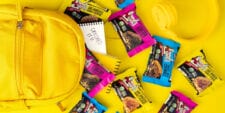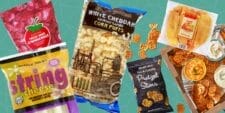Stop dreading lunchbox prep with these 10 expert-approved tricks

August de Richelieu/ Pexels
Here are 10 tips for making school lunch work for you, rather than just a lot of work.

Table of Contents
School lunch is always a win, because packing it means we’re sending our kids out into the world prepared to have an independent experience. And isn’t that the whole point of parenting, really? Yet, in writing our cookbook, Lunchbox, my co-author Jen Stevenson and I discovered that parents aren’t embracing the victory. If anything, they feel as though they’re failing.
Maybe it’s because school lunch is a meal with no reference point: we don’t watch our kids eat it and we have no idea what other parents are packing. There are also more elements in it than ever before, thanks to the recent conversion in cafeterias from the brown bag to the bento-style lunchbox. Or maybe it’s because we are implicitly graded on our work, opening the lunchbox at the end of the day to receive either a rare parenting gold star (in the form of an empty container) or an F (for full.)
But likely it’s because the meal has tremendous emotional weight. Who doesn’t remember how their own school lunch made them feel? We all want our kids to feel as though lunch is a love note from home that’s passed in the middle of the day, but we’re also quite busy, so it’s easy for lunch to fall into a repetitious rut and for parents to feel bad about that.
Having photographed 100 lunchboxes for our book and seen inside countless more, we think it’s time to flip the script on school lunches and take advantage of their unique properties.
Here are 10 tips for making school lunch work for you, rather than just a lot of work.
1. Make a list
The main components of a lunchbox are as follows: fruit, vegetable, main, crunchy snack, protein snack, something sweet. Sitting down with your second grader and asking for 3-5 of their favorite foods in each category is a great way to establish a lunchbox shopping list you can revisit time and again. It’s also an intuitive introduction into planning a balanced meal that will set the stage for them to one day (hopefully, soon!) pack their own lunch.
2. Share it twice
Once you’ve established the foods they’d like to see in their lunchbox, send the list to everyone who might pack it — whether that’s a co-parent, partner, grandparent, nanny, or babysitter. (Or load it into your grocery store app for quick re-orders.) We all know that meal planning can take as much (or more!) time as meal making; when you’re looking to share the lunch labor, start where the task begins.
3. Think outside the bread box
There’s no hard and fast rule that school lunch needs to include a sandwich, and many kids don’t like them. Cheese and crackers, hummus and crackers, tofu and edamame, turkey/salami/ham rolls, shredded rotisserie chicken, sausage slices, pasta salad or sesame noodles are all worthy substitutes.
4. Shape up
Before I had a selective eater, I might have rolled my eyes at the 1-inch food cutters that make cheese, vegetables, and sandwiches go from ho-hum to “hey, that’s cute” in less than five seconds, but watching your child try a new vegetable for the first time simply because it spells “Y-U-M” could convert anyone. Food cutters are undoubtedly the quickest way to give lunch a personal touch, but if you’re not in the market for lunchbox accessories, varying how their sandwich looks (triangles vs. squares, crusts-off tea sandwiches vs. crust-on whole sandwich) is a gentle way to encourage flexibility. Our favorite no special tools trick is to make a sandwich with one slice white bread, one slice wheat bread, cut it into triangles, and flip over two.
5. Try new things
No matter what, don’t sleep on the lunchbox’s unique ability to expose your child to new foods. When they’re hungry and distractedly chatting in the lunchroom, they might just try that food they’ve previously rejected. Especially because you never know when their best friend will also have said rejected item in their lunchbox, rendering it suddenly compelling. Peer pressure can be positive, too. If they don’t eat it, no biggie.
6. Party on
Hit the appetizers section of the freezer aisle for two-bite foods that are perfectly sized for lunchbox compartments. Mini quiches, tiny tacos, pigs in a blanket, bagel bites, and gyoza are crowd-pleasing mains. Macarons, lemon bars, and mini eclairs make for delicious desserts. And while, yes, you could pack hot foods in the thermos container, you can also take advantage of the school age set’s deep love of lukewarm food. Dino nuggets are rarely rejected, no matter the temperature.
7. Take the shortcut
Instagram is not reality, and it’s perfectly fine to give lunch your all one day and phone it in the next. As anyone who’s ever fed a child knows, the amount of time you dedicate to cooking for kids has no relationship with how much they’ll love it. Freeze ahead peanut butter and jelly sandwiches (pro tip: use a sandwich press and seal), microwave soup and send it in a thermos, or take a tip from the divorced dad whose daughter’s lunch I envied in grade school and pick up a bagel and cream cheese on the way to school. Some days, done = good.
8. Teensy treats
Many popular lunchboxes have a tiny compartment for treats. Invariably, it’s the last section to be filled, and can be something of a stumper. To save you time better spent doing something else, here’s a list of foods that fit in it: chocolate chips, yogurt drops, raisins, blueberries, yogurt-covered raisins, cereal, fruit snacks, chocolate candies, jelly beans, nuts, cheese cubes, Teddy Grahams/Annie’s bunnies, Goldfish crackers/Annie’s crackers, a folded note, just a few berries, mini marshmallows.
9. Let them have their cake and eat it first, too
Of all the classic food power struggles between parents and children, the question of if/whether/what/when dessert will be served reigns supreme. Lunchboxes solve for this struggle by never engaging in it. Here, their cookie has equal weight to the rest of the foods. And while that in and of itself is exciting, it doesn’t overtake the whole meal. Let this be a lesson for dinner, too.
10. Exit interview
When your kids stonewall the school day debrief (e.g. Q: “How was school?” A: “Good”) ask them what their friends had for lunch, and if they saw anything they’d like to try. It gets them talking every time.
This story is a part of The Motherly Collective contributor network where we showcase the stories, experiences and advice from brands, writers and experts who want to share their perspective with our community. We believe that there is no single story of motherhood, and that every mother's journey is unique. By amplifying each mother's experience and offering expert-driven content, we can support, inform and inspire each other on this incredible journey. If you're interested in contributing to The Motherly Collective please click here.



































